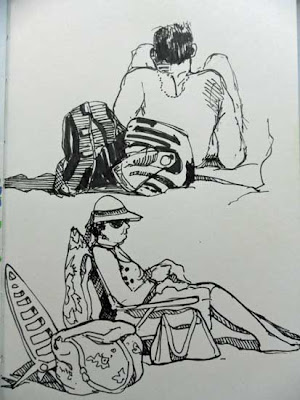We went to London last week-end and parked the car in Kensington Gardens, almost in front of the Serpentine Gallery, which exhibits modern and contemporary art. The gallery is not far from Diana, Princess of Wales Memorial Fountain.
The current exhibition in the main gallery, until 17 September 2011, is an installation titled The Mirror of Judgement by the Italian artist Michelangelo Pistoletto. It is a maze made of sheet of cardboards, with a number of world religion symbols placed along the visitor’s path. More details and photographs are available on the page for the exhibition.
The bookshop stocks a fine selection of books on contemporary art, photography, architecture, design, as well as cutting-edge art reviews. I recommend a visit.
Next to the main gallery is the Serpentine Gallery Pavilion. The current i(1 July - 16 October 2011) has been designed by Peter Zumthor and is called Hortus Conclusus. The pavilion is totally black with a long garden in the centre. The flowers in the border make a wild arrangement of herbs and flowers. There is a sharp contrast between the pure lines of the black building and the organic and colourful explosion of the garden.
The two things I liked are that quietness of the place, with the table and chairs arranged under the roof, around the garden; and the fact that there is no way to suspect, from the austere outside of the pavilion, the beauty of the inside.
The weather was uncertain and the pavilion was a calm shelter to drink the coffee we bought at the old Renault van parked on the side of the Serpentine Gallery.
The gallery is small and therefore a good way to introduce young children to contemporary art without boring them.
Practical details
Serpentine Gallery
Kensington Gardens
London W2 3XA
T 020 7402 6075
F 020 7402 4103
Open daily, 10am - 6pm (note that the Serpentine Gallery is closed to the public in the period between exhibitions. The Bookshop remains open at all times).
Admission free
Website: http://www.serpentinegallery.org/


















